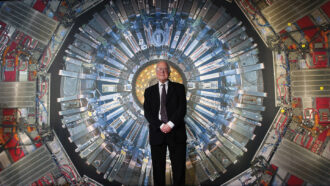
Elusive
Frank Close
Basic Books, $30
There’s a lot more to the story of the Higgs boson than just one man named Higgs.
Despite the appeal of the “lone genius” narrative, it’s rare that a discovery can be attributed solely to the work of one scientist. At first, Elusive, a biography of Peter Higgs written by physicist and author Frank Close, seems to play into that misleading narrative: The book is subtitled “How Peter Higgs solved the mystery of mass.”
But the book quickly — and rightfully — veers from that path as it delves into the theoretical twists and turns that kicked off a decades-long quest for the particle known as the Higgs boson, culminating with its discovery in 2012 (SN: 7/28/12, p. 5). That detection verified the mechanism by which particles gain mass. Higgs, of the University of Edinburgh, played a crucial role in establishing mass’s origins, but he was one of many contributors.
The habitually modest and attention-averse Higgs makes the case against himself as the one whiz behind the discovery, the book notes: According to Higgs, “my actual contribution was only a key insight right at the end of the story.”
The Higgs boson itself doesn’t bestow fundamental particles with mass. Instead, its discovery confirmed the correctness of a theory cooked up by Higgs and others. According to that theory, elementary particles gain mass by interacting with a field, now known as the Higgs field, that pervades all of space.
A paper from Higgs in 1964 was not the first to propose this process. Physicists Robert Brout and François Englert just barely beat him to it. And another team of researchers published the same idea just after Higgs (SN: 11/2/13, p. 4). Crucial groundwork had already been laid by yet other scientists, and still others followed up on Higgs’ work. Higgs, however, was the one to make the pivotal point that the mass mechanism implied the existence of a new, massive particle, which could confirm the theory.
Despite this complicated history, scientists slapped his name on not just the particle, the Higgs boson, but also the process behind it, traditionally called the Higgs mechanism, but more recently and accurately termed the Brout-Englert-Higgs mechanism. (Higgs has reportedly proposed calling it the “ABEGHHK’tH mechanism,” using the first letter of the last names of the parade of physicists who contributed to it, Anderson, Brout, Englert, Guralnik, Hagen, Higgs, Kibble and ’t Hooft.) The postmortem of how Higgs’ name attained outsize importance is one of the most interesting sections of Elusive, revealing much about the scientific sausage-making process and how it sometimes goes awry. Equally fascinating is the account of how the media embraced Higgs as a titan of physics based on his association with the boson, lofting him to a level of fame that, for Higgs, felt unwelcome and unwarranted.
The book admirably tackles the complexities of the Brout-Englert-Higgs mechanism and how particles gain mass, covering details that are usually glossed over in most popular explanations. Close doesn’t shy away from nitty-gritty physics terms like “perturbation theory,” “renormalization” and “gauge invariance.” The thorniest bits are most appropriate for amateur physics aficionados who desire a deeper understanding, and those bits may require a reread before sinking in.
Higgs is famously not a fan of the limelight — he disappeared for several hours on the day he won a Nobel Prize for his work on mass. The physicist sometimes seems to fade into the background of this biography as well, with multiple pages passing with no appearance or contribution from Higgs. Once the scientific community got wind of the possibility of a new particle, the idea took on a life of its own, with experimental physicists leading the charge. Higgs didn’t make many contributions to the subject beyond his initial insight, which he calls “the only really original idea I’ve ever had.”
Thus, the book sometimes feels like a biography of a particle named Higgs, with the person playing a backup role. Higgs is so reserved and so private that you get the sense that Close still hasn’t quite cracked him. While interesting details of Higgs’ life and passions are revealed — for example, his fervent objection to nuclear weapons — deeper insights are missing. In the end, Higgs is, just like the particle named after him, elusive.
Buy Elusive from Bookshop.org. Science News is a Bookshop.org affiliate and will earn a commission on purchases made from links in this article.

 A new treatment could restore some mobility in people paralyzed by strokes
A new treatment could restore some mobility in people paralyzed by strokes  What has Perseverance found in two years on Mars?
What has Perseverance found in two years on Mars?  This robot automatically tucks its limbs to squeeze through spaces
This robot automatically tucks its limbs to squeeze through spaces  Greta Thunberg’s new book urges the world to take climate action now
Greta Thunberg’s new book urges the world to take climate action now  Glassy eyes may help young crustaceans hide from predators in plain sight
Glassy eyes may help young crustaceans hide from predators in plain sight  A chemical imbalance doesn’t explain depression. So what does?
A chemical imbalance doesn’t explain depression. So what does?